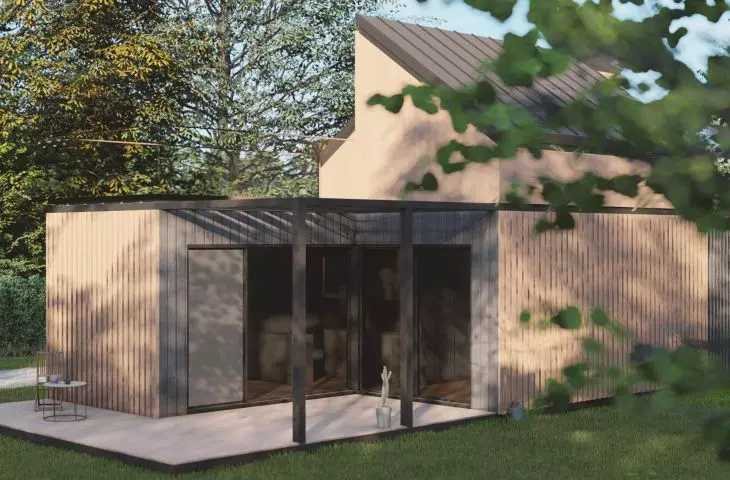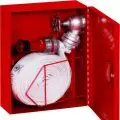Pawel Dworczyk and Szymon Fischer, graduates of the Faculty of Industrial Forms at the Jan Matejko Academy of Fine Arts in Krakow, in response to global warming and the dynamically changing conditions of modern life, decided to create a proposal for flexible housing solutions. Meet HOMEST - a service based on the technology of passive and energy-efficient prefabricated buildings.
The diploma project entitled Contemporary Housing Models. A system to support design and sales was created under the direction of Dr. Krzysztof Bogomaz.
The HOMEST system allows you to design your own house from modules
© Paweł Dworczyk, Szymon Fischer
Our diploma project is a proposal to use prefabricated technology to propose a system for sustainable development and flexible housing solutions. One of the biggest challenges we have to face in at least the next few decades is global warming and its consequences. Since the problem is global and of enormous magnitude, we have decided to focus on one of the most damaging sectors responsible for greenhouse gas emissions, the construction and housing sector. Many factors contribute to gas emissions in this industry. From the extraction and production of materials, to their transportation, to the construction process and finally the use of the building. The increasingly popular technology of prefabricated buildings provides an opportunity to rethink and redesign some of these processes. In addition to purely manufacturing and technological issues, we also have the opportunity to propose how we buy buildings and live in them, the authors say.
The configurator user has an impact on the appearance of his or her home
© Paweł Dworczyk, Szymon Fischer
HOMEST
The HOMEST system was designed by graduates of the Department of Industrial Forms, for whom it was important to consider a wide audience: investors, manufacturers, franchisees and customers. The designers also researched the path of the user and franchisee to locate key problems and opportunities in the process of buying and building a house.
The authors considered a wide range of audiences
© Pawel Dworczyk, Szymon Fischer
Due to rising loan installments and inflation, young people are finding it increasingly difficult to purchase their first four walls. On the other hand, the price per square meter in cities is hitting record highs, and developers are outdoing themselves in creating smaller and smaller cottages. On the other hand, there is growing interest in building plots and houses. Such plots of land near a city in a metropolitan area are able to compete in price with apartments in the centers, and the hybrid mode of work and increasingly better connections on public transportation, for example, encourage people to live in a house, not an apartment. To accelerate the possibility of living on one's own, we decided to design a system of modules that can be added to the existing ones, regardless of the stage, the designers explain.
Initially, the house is composed of two modules, then more can be added
© Pawel Dworczyk, Szymon Fischer
a house made of modules
The starting point is a house composed of two rectangular modules, creating less than 30 square meters of living space. It is possible to start construction with two such modules and add more to expand when, for example, new funds appear or the owner's needs change. The addition of a module can be used to enlarge the living space or put up a terrace, office or garage.
The basic modules are 3×6×3.2 meters, thus fitting within the standard dimensions carried by trucks. The modules can be fully finished at the factory, significantly speeding up lead times and lowering production costs.
The modules fit into standard dimensions carried by trucks
© Pawel Dworczyk, Szymon Fischer
The modules have a simple construction along the lines of frame houses, and each wall is a separate frame, allowing the replacement of a wall or the addition of a new module. The walls are designed to also fit into the sustainability strategy. The frame can be made of locally harvested wood, insulation is provided by cellulose filler. Such a wall is covered with a WPC (wood plastic composite) panel, to which facade panels are mounted.
In the configurator you can choose the building layout
© Paweł Dworczyk, Szymon Fischer
reuse, recycle
The modular house can not only be enlarged, but also reduced in size.
The user has not only the possibility to add a module, but also to resell it. In case the owner no longer needs a large living space, when, for example, his children move out, the module can be acquired by the manufacturer, refurbished and sold again. This is the premise of a closed-loop economy, where a product is used for as long as possible, the authors explain.
Modules can be supplied, but also resold
© Paweł Dworczyk, Szymon Fischer
The buildings were designed in three versions: energy efficient, passive and plus energy. As energy sources, the ASP graduates proposed heat pumps and new-generation photovoltaic panels, which meld with the black roof made of standing seam metal.
personalization, portal and configurator
Since the building blocks formed from the perpendiculars are relatively repetitive, the designers decided to offer different versions of the facade panels, such as laths of different color and arrangement, or even terracotta panels. Thus, the user has quite a range of options to customize the house to his taste.
The authors have proposed different versions of facade panels
© Pawel Dworczyk, Szymon Fischer
To further streamline the process of designing and buying a modular building, the authors created the concept of a portal and configurator. It allows users to learn about the possibilities of their plot of land, see the offer and price, and pre-configure their dream home.
Our tool is meant to streamline the service, not eliminate the architect from the process. The role of the architect is still important to propose a realistic and practical solution. The whole system, thanks to the proposed facilities and lowering of the entry threshold, aims to spread the technology of eco-friendly prefabricated houses and thus positively affect the serious problems of the construction and housing industry," conclude Pawel Dworczyk and Szymon Fischer.























































